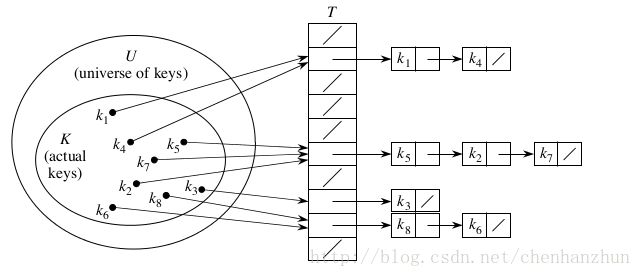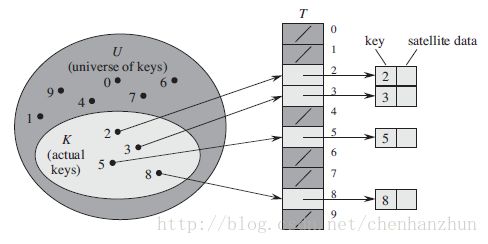数据结构——哈希表(散列表)
导言:
数组的特点是:寻址容易,插入和删除困难;而链表的特点是:寻址困难,插入和删除容易。那么我们能不能综合两者的特性,做出一种寻址容易,插入删除也容易的数据结构?答案是肯定的,这就是我们要提起的哈希表,哈希表有多种不同的实现方法,我接下来解释的是最常用的一种方法——拉链法,我们可以理解为“链表的数组”,拉接法的思路是:如果多个关键字映射到了哈希表的同一个位置处,则将这些关键字记录在同一个线性链表中。结构如下图所示:(注:以下是单链表实现,若为了方便删除数据,也可以使用双向链表实现)
直接寻址表:
当关键字的全域U比较小时,直接寻址是一种简单有效的技术。关键字大小直接与元素所在的位置序号相等,不会出现冲突的情况。其结构图如下所示:
哈希表:
如果全域U很大时,直接寻址表存在的很明显的缺点。这时采用一种映射关系得到由哈希值组成的哈希表,使存储空间利用率更高。但是,哈希表存在的冲突情况,即不同的关键字在哈希函数的映射下得到相同的哈希值。为了解决这种冲突,可以采用一些有用的方法,例如:拉链法,开放寻址等。哈希表的确定主要是哈希函数的选择。
哈希函数:
除法散列法
哈希函数如下:
![]()
式中表示在基数m中对关键字k取余,其中m的取值最好为一个不太接近2的整数幂的素数。
乘法散列法
哈希函数如下:
![]()
式中,m一般取2的某个次幂,k为关键字,A为某个参数一般取黄金分割值,kA(mod)1表示取kA的小数部分。
单链表实现的源程序:
#ifndef HASHTABLE_LINKLIST_H_INCLUDE
#define HASHTABLE_LINKLIST_H_INCLUDE
#define M 5
typedef int Elemtype;
typedef struct Node
{
Elemtype data;
struct Node *next;
}Node,*pNode;
typedef struct HashNode
{
pNode head;
}HashNode,*HashTable;
//创建哈希表
HashTable Creat_HashTable(int n);
//插入数据
void Insert_HashTable(HashTable HT,Elemtype data);
//查找数据
pNode Search_HashTable(HashTable HT,Elemtype key);
//删除数据
void Delete_HashTable(HashTable HT,Elemtype key);
#endif
/*****************************************
****该哈希表是利用单链表解决冲突问题的****
*****************************************/
#include
#include
#include "HashTable_LinkList.h"
//创建哈希表
HashTable Creat_HashTable(int n)
{
//分配哈希表所需的地址空间
HashTable HT = (HashTable)malloc(n*sizeof(HashNode));
if (!HT)
{
printf("malloc the HashTable is failed.\n");
exit(1);
}
//初始化空哈希表
int i;
for (i = 0;i < n;i++)
{
HT[i].head = NULL;
}
return HT;
}
//插入数据
void Insert_HashTable(HashTable HT,Elemtype data)
{
//查找哈希表是否存在要插入的数据
//若存在则插入不成功,并退出
if (Search_HashTable(HT,data))
{
printf("the data of %d you want to insert is exist.\n",data);
exit(1);
}
else
{
pNode pNew = (pNode)malloc(sizeof(Node));
if (!pNew)
{
printf("malloc the memory is failed.\n");
exit(1);
}
//把数据插入到链表尾部
pNew->data = data;
pNew->next = NULL;
//哈希函数采用除法散列法
int h = data%M;
pNode pCur = HT[h].head;
if (NULL == pCur)
{
HT[h].head = pNew;
}
else
{
while (pCur->next)
{
pCur = pCur->next;
}
pCur->next = pNew;
}
printf("Insert the data of %d is success.\n",data);
}
}
//查找数据
pNode Search_HashTable(HashTable HT,Elemtype key)
{
if(!HT)
return NULL;
int h = key%M;
pNode pCur = HT[h].head;
while(pCur && pCur->data != key)
pCur = pCur->next;
return pCur;
}
//删除数据
void Delete_HashTable(HashTable HT,Elemtype key)
{
if (!Search_HashTable(HT,key))
{
printf("the data is not exist");
exit(1);
}
else
{
int h = key%M;
pNode pCur = HT[h].head;
if(pCur->data == key)//该数据为第一个节点
HT[h].head = pCur->next;
else
{
pNode pre = pCur;//当前节点的前一个节点;
while (pCur && pCur->data != key)
{
pre = pCur;
pCur = pCur->next;
}
pre->next = pCur->next;
}
free(pCur);
printf("delete the data of %d is success.\n",key);
}
}
#include
#include "HashTable_LinkList.h"
int main()
{
int n_len = 10;
int Array[]={1,5,8,10,15,17};
//创建哈希表并插入数据
HashTable HT = Creat_HashTable(n_len);
int i;
for (i=0;i<6;i++)
{
Insert_HashTable(HT,Array[i]);
}
//查找数据
pNode p = Search_HashTable(HT,8);
if (p)
{
printf("the data is exist.\n");
}
else
{
printf("the data is not exist.\n");
}
//删除数据
Delete_HashTable(HT,15);
p = Search_HashTable(HT,15);
if (p)
{
printf("the data is exist.\n");
}
else
{
printf("the data is not exist.\n");
}
return 0;
}
开放寻址法:
开放寻址法是解决冲突的另一种办法。
(1)线性探查:h(k,i)=(h'(k)+i) mod m,可能有“一次群集”问题,即随着插入的元素越来越多,操作时间越来越慢。
(2)二次探查:h(k,i)=(h'(k)+ai+bi^2) mod m,可能有“二次群集”问题,即如果h(k1,0)=h(k2,0),则探查序列就一致。
(3)二次哈希:h(k,i)=(h1(k)+ih2(k)) mod m ,要求m和h2(k)互质,不然探查序列不能覆盖到整个下标。算法导论11.4-3证明了这点。
参考资料:
http://blog.csdn.net/xiazdong/article/details/8559751
http://blog.csdn.net/ns_code/article/details/20763801
http://blog.csdn.net/dc_726/article/details/7346583

